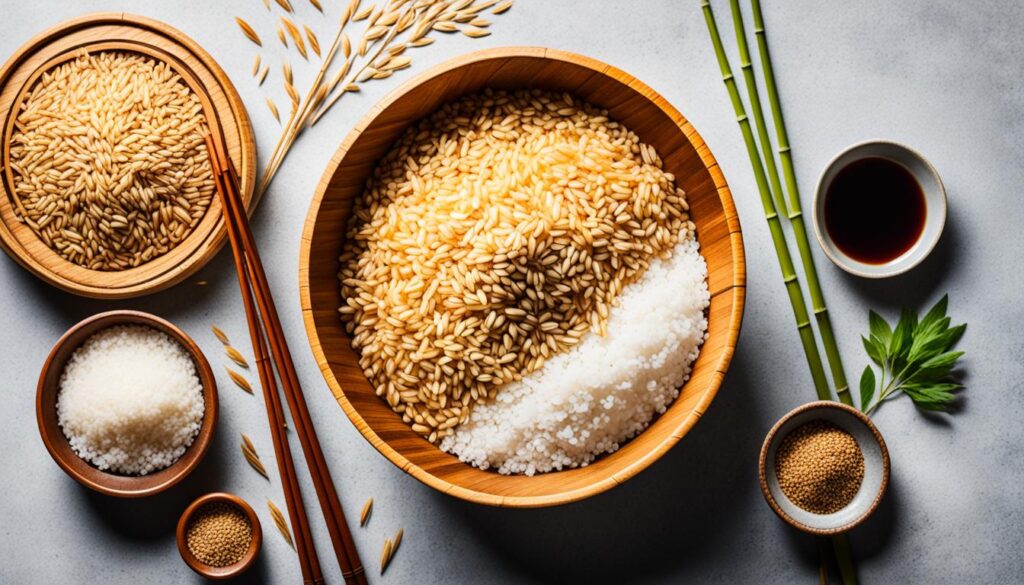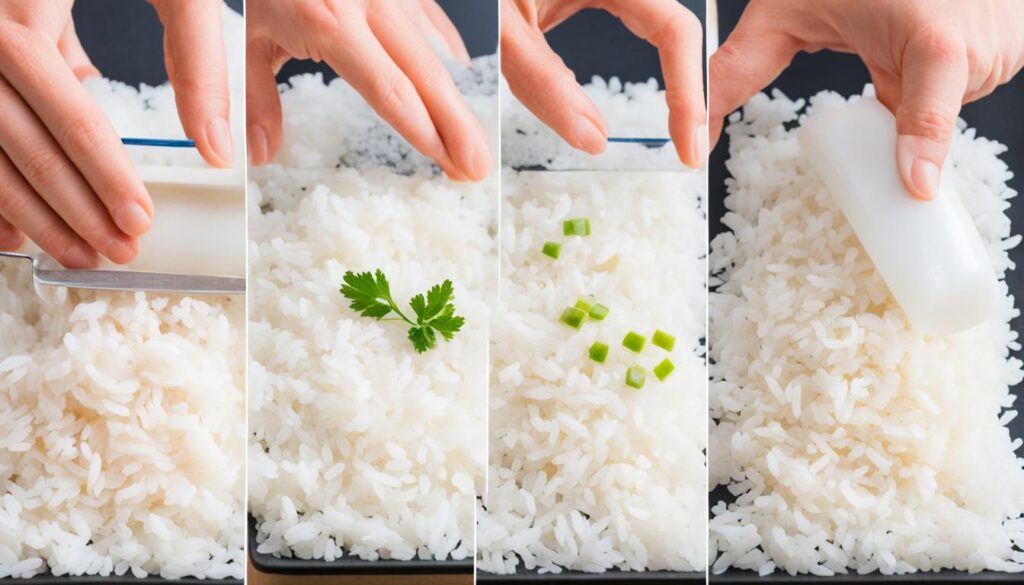Are you a sushi enthusiast looking to elevate your homemade sushi game? Look no further than our sushi rice recipe, which will guide you through the process of creating the perfect foundation for your sushi rolls. With just a few simple ingredients and our step-by-step instructions, you’ll be making flavorful and sticky sushi rice in no time.
When it comes to sushi, the quality of the rice is just as important as the other ingredients. Our recipe uses Japanese-style short-grain white rice, known for its sticky and firm texture. We recommend choosing a high-quality rice brand such as Lundberg Farms, Nishiki, or Kokuho Rose to achieve the best results.
To achieve the signature tangy flavor of sushi rice, you’ll need rice vinegar, sugar, and fine sea salt. These ingredients combine to create a slightly sweet and flavorful rice that perfectly complements the other components of your sushi rolls. Optional ingredients include kombu, which adds a traditional umami flavor to the rice.
Now, let’s dive into the step-by-step process of cooking and seasoning sushi rice. From rinsing the rice to folding in the sushi vinegar, we’ll walk you through each stage to ensure your rice is evenly seasoned and has a glossy appearance.
Key Takeaways:
- Choose a high-quality, Japanese-style short-grain white rice for the best sushi rice texture.
- Ingredients like rice vinegar, sugar, and fine sea salt give sushi rice its tangy and slightly sweet flavor.
- Optional ingredients like kombu can add traditional umami flavor to your sushi rice.
- Follow our step-by-step instructions to cook and season the rice for optimal results.
- Experiment with variations and tips, such as soaking the rice before cooking or using a large mixing bowl for folding, to suit your preferences.
Essential Ingredients for Sushi Rice
To make sushi rice, you will need a few essential ingredients that create the perfect balance of flavor and texture. The star of the show is Japanese-style short-grain white rice, renowned for its sticky and firm consistency. Opt for reputable rice brands like Lundberg Farms, Nishiki, or Kokuho Rose to ensure the best quality grains for your sushi.
In addition to rice, there are a few other key ingredients that enhance the taste of sushi rice. The secret to achieving the tangy and slightly sweet flavor lies in rice vinegar, sugar, and fine sea salt. These three ingredients are carefully combined to create the signature taste of traditional sushi rice.
For those seeking an extra layer of umami flavor, consider adding kombuâa type of edible kelpâto the rice mixture. Kombu infuses the sushi rice with a distinctive savory taste, elevating the overall flavor profile of your sushi creations.
“Choosing high-quality rice and using the right combination of ingredients is crucial to achieving authentic sushi rice.” – Sushi Chef Hiroshi
Essential Ingredients for Sushi Rice
| Ingredients | Description |
|---|---|
| Japanese-style short-grain white rice | Provides the sticky and firm texture that is characteristic of sushi rice. Recommended brands include Lundberg Farms, Nishiki, or Kokuho Rose. |
| Rice vinegar | Imparts a tangy flavor to the rice, adding a delightful acidity to complement the other ingredients. |
| Sugar | Adds a touch of sweetness to balance the flavors and enhance the overall taste of the sushi rice. |
| Fine sea salt | Brings out the natural flavors of the rice and enhances the taste of the sushi rice. |
| Kombu (optional) | Offers a traditional umami flavor that deepens the taste profile of the sushi rice. |

Cooking and Seasoning Sushi Rice
The process of cooking and seasoning sushi rice is relatively simple, but it requires attention to detail to achieve the perfect texture and flavor. Follow these step-by-step instructions to create delicious sushi rice that will elevate your homemade sushi.
Step 1: Rinse the Rice
Start by rinsing the rice under cold water to remove excess starch. Place the rice in a fine-mesh sieve and gently wash it, using your fingers to agitate the grains. Continue rinsing until the water runs clear.
Step 2: Cook the Rice
Transfer the rinsed rice to a pot and add water in a ratio of 1:1.5 (1 cup of rice to 1.5 cups of water). Cover the pot and bring it to a boil over medium heat. Once boiling, reduce the heat to low and simmer for about 15 minutes or until the rice is tender and the water is absorbed.
Step 3: Prepare the Sushi Seasoning
In a small saucepan, combine rice vinegar, sugar, and salt. Heat the mixture over low heat, stirring until the sugar and salt are completely dissolved. Remove from heat and let it cool.
Step 4: Season the Cooked Rice
Transfer the cooked rice to a large bowl. Gradually pour the sushi seasoning over the rice, folding it gently with a wooden spatula or rice paddle. Be careful not to mash the grains. Continue folding until the rice is evenly coated with the seasoning and has a glossy appearance.
Now, you have perfectly cooked and seasoned sushi rice ready to be used in your favorite sushi recipes. The balance of flavors provided by the rice vinegar, sugar, and salt will enhance the taste of your homemade sushi rolls.

Variations and Tips for Making Sushi Rice
While the traditional method of making sushi rice involves soaking the rinsed rice before cooking and using a wooden hangiri and rice paddle for mixing, there are variations and tips that can simplify the process. Soaking the rice before cooking can help improve the texture, but it is not necessary. Additionally, you can use a large mixing bowl and spatula for folding the rice instead of a hangiri and paddle. Cooling the rice quickly can be achieved by spreading it out on a baking sheet and gently folding it. These variations and tips allow for flexibility and convenience in making sushi rice.
| Variation/Tips | Description |
|---|---|
| 1. Skip the Soaking | You can skip the step of soaking the rice before cooking. This saves time and simplifies the preparation process. |
| 2. Substitute Hangiri and Paddle | If you don’t have a hangiri and paddle, you can use a large mixing bowl and a spatula to fold the rice. This alternative method works just as well. |
| 3. Quick Cooling | Spread the cooked rice out on a baking sheet and gently fold it to cool it quickly. This helps maintain the desired texture and prevents the rice from becoming mushy. |
Experimenting with these variations and tips will help you find the method that works best for you. Whether you choose to follow the traditional method or try a simplified approach, the key is to achieve the desired texture and flavor in your sushi rice.
Remember, practice makes perfect, so don’t be discouraged if your first attempt is not perfect. With time and experience, you will become a master of making sushi rice.
Conclusion
Making sushi rice is an essential skill for any sushi enthusiast looking to elevate their homemade sushi. By following the step-by-step instructions and using the recommended ingredients, you can create a truly delectable sushi rice that will enhance the flavors and textures of your sushi creations. Whether you enjoy traditional sushi rolls or prefer to experiment with more creative variations, mastering the art of sushi rice will take your sushi-making to new heights.
Using the best sushi rice recipe is key to achieving the perfect balance of flavors in your sushi rice. High-quality Japanese-style short-grain white rice, such as Lundberg Farms, Nishiki, or Kokuho Rose, should be your go-to choice. The sticky and firm texture of this rice variety will provide the ideal foundation for your sushi. Pair it with the tangy and slightly sweet taste of rice vinegar, sugar, and fine sea salt, and you’ll have a winning combination.
With practice and attention to detail, you’ll become more confident in your sushi rice-making skills. Remember, the rice should be evenly seasoned and have a glossy appearance. While there are variations and tips that can simplify the process, such as skipping the soaking step and using a mixing bowl instead of a hangiri and paddle, don’t be afraid to experiment and find what works best for you.
So, gather your ingredients, follow the recipe, and get ready to impress your friends and family with your homemade sushi creations. With the best sushi rice recipe in your arsenal, there’s no limit to the delicious sushi you can make. Enjoy!
FAQ
What kind of rice should I use for sushi?
Japanese-style short-grain white rice is the best choice for sushi. Brands like Lundberg Farms, Nishiki, or Kokuho Rose are highly recommended.
What are the essential ingredients for sushi rice?
The main ingredients for sushi rice are Japanese-style short-grain white rice, rice vinegar, sugar, and fine sea salt. Optional ingredients include kombu for added umami flavor.
How do I cook and season sushi rice?
After rinsing the rice, cook it until tender and prepare a mixture of rice vinegar, sugar, and salt. Heat the mixture, then gently fold and mix it with the cooked rice, taking care not to mash the grains.
What are some tips for making sushi rice?
While the traditional method involves soaking the rice before cooking and using a wooden hangiri and rice paddle, these steps are not necessary. You can use a large mixing bowl and spatula for folding the rice, and cool it quickly by spreading it out on a baking sheet.
What is the best sushi rice recipe?
By following the step-by-step instructions and using the recommended ingredients, you can achieve the perfect balance of flavors and textures in your sushi rice, making it the best sushi rice recipe for homemade sushi.